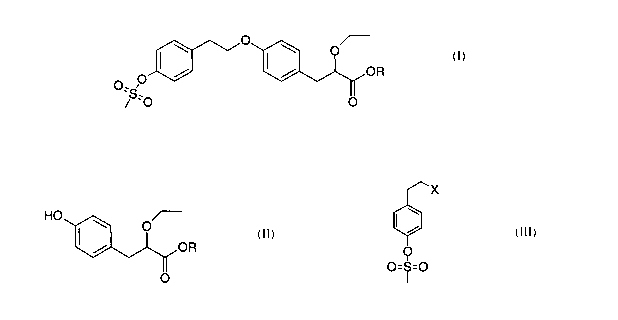Some of the information on this Web page has been provided by external sources. The Government of Canada is not responsible for the accuracy, reliability or currency of the information supplied by external sources. Users wishing to rely upon this information should consult directly with the source of the information. Content provided by external sources is not subject to official languages, privacy and accessibility requirements.
Any discrepancies in the text and image of the Claims and Abstract are due to differing posting times. Text of the Claims and Abstract are posted:
| (12) Patent Application: | (11) CA 2478650 |
|---|---|
| (54) English Title: | PROCESS FOR THE PREPARATION OF 2-ETHOXY-3-[4-(2-{METHANESULPHONYLOXYPHENYL}ETHOXY) PHENIL] PROPANOIC ACID |
| (54) French Title: | NOUVEAU PROCEDE |
| Status: | Deemed Abandoned and Beyond the Period of Reinstatement - Pending Response to Notice of Disregarded Communication |
| (51) International Patent Classification (IPC): |
|
|---|---|
| (72) Inventors : |
|
| (73) Owners : |
|
| (71) Applicants : |
|
| (74) Agent: | SMART & BIGGAR LP |
| (74) Associate agent: | |
| (45) Issued: | |
| (86) PCT Filing Date: | 2003-03-28 |
| (87) Open to Public Inspection: | 2003-10-09 |
| Examination requested: | 2005-11-16 |
| Availability of licence: | N/A |
| Dedicated to the Public: | N/A |
| (25) Language of filing: | English |
| Patent Cooperation Treaty (PCT): | Yes |
|---|---|
| (86) PCT Filing Number: | PCT/GB2003/001395 |
| (87) International Publication Number: | WO 2003082812 |
| (85) National Entry: | 2004-09-03 |
| (30) Application Priority Data: | ||||||
|---|---|---|---|---|---|---|
|
A process for the preparation of a compound of formula (I); in which R
represents H or an acid protecting group which comprises reacting a compound
of formula (II); in which R is as previously defined with a compound of
formula (III); wherein X is a suitable leaving group in the presence of a base
and using water as a diluent.
L'invention concerne un procédé de préparation d'un composé de formule générale (I) dans laquelle R représente H ou un groupe protecteur d'acide. Ce procédé consiste à faire réagir un composé de formule générale (II) dans laquelle R a la signification indiqué précédemment, avec un composé de formule générale (III) dans laquelle X est un groupe partant approprié, en présence d'une base et au moyen d'eau en tant que diluent.
Note: Claims are shown in the official language in which they were submitted.
Note: Descriptions are shown in the official language in which they were submitted.

2024-08-01:As part of the Next Generation Patents (NGP) transition, the Canadian Patents Database (CPD) now contains a more detailed Event History, which replicates the Event Log of our new back-office solution.
Please note that "Inactive:" events refers to events no longer in use in our new back-office solution.
For a clearer understanding of the status of the application/patent presented on this page, the site Disclaimer , as well as the definitions for Patent , Event History , Maintenance Fee and Payment History should be consulted.
| Description | Date |
|---|---|
| Application Not Reinstated by Deadline | 2008-03-28 |
| Time Limit for Reversal Expired | 2008-03-28 |
| Deemed Abandoned - Failure to Respond to Maintenance Fee Notice | 2007-03-28 |
| Inactive: Acknowledgment of national entry - RFE | 2006-03-10 |
| Letter Sent | 2005-11-24 |
| Request for Examination Received | 2005-11-16 |
| Request for Examination Requirements Determined Compliant | 2005-11-16 |
| All Requirements for Examination Determined Compliant | 2005-11-16 |
| Inactive: Filing certificate correction | 2005-04-27 |
| Inactive: Applicant deleted | 2005-02-17 |
| Inactive: Notice - National entry - No RFE | 2005-02-17 |
| Inactive: Correspondence - Transfer | 2005-02-09 |
| Inactive: Filing certificate correction | 2005-02-09 |
| Inactive: Filing certificate correction | 2004-11-22 |
| Inactive: Correspondence - Transfer | 2004-11-22 |
| Inactive: Cover page published | 2004-11-09 |
| Letter Sent | 2004-11-04 |
| Letter Sent | 2004-11-04 |
| Inactive: Notice - National entry - No RFE | 2004-11-04 |
| Application Received - PCT | 2004-10-05 |
| National Entry Requirements Determined Compliant | 2004-09-03 |
| Application Published (Open to Public Inspection) | 2003-10-09 |
| Abandonment Date | Reason | Reinstatement Date |
|---|---|---|
| 2007-03-28 |
The last payment was received on 2005-12-12
Note : If the full payment has not been received on or before the date indicated, a further fee may be required which may be one of the following
Please refer to the CIPO Patent Fees web page to see all current fee amounts.
| Fee Type | Anniversary Year | Due Date | Paid Date |
|---|---|---|---|
| Registration of a document | 2004-09-03 | ||
| Basic national fee - standard | 2004-09-03 | ||
| MF (application, 2nd anniv.) - standard | 02 | 2005-03-28 | 2004-12-13 |
| Request for examination - standard | 2005-11-16 | ||
| MF (application, 3rd anniv.) - standard | 03 | 2006-03-28 | 2005-12-12 |
Note: Records showing the ownership history in alphabetical order.
| Current Owners on Record |
|---|
| ASTRAZENECA AB |
| Past Owners on Record |
|---|
| MARIA LARSSON |